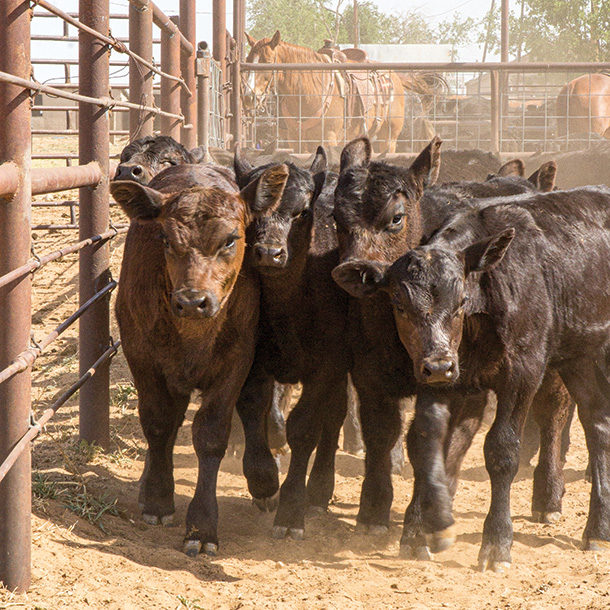Sunk cost fallacy: A tendency for people to irrationally follow through on an activity that is not meeting their expectations because of the time and/or money already invested.
Have you ever gotten a cheeseburger at a fast-food restaurant that was not prepared to your liking, yet you ate it anyway? If so, you have fallen for the sunk cost fallacy. “I already paid for it, so I better eat it.” The sunk cost fallacy is holding many, many beef operations back across the country. We could cover several areas where the sunk cost fallacy applies, but today I am going to focus on weaning calves.
Over 57% of calves in this country are weaned on the trailer destined for a sale barn. While this management system is valued for its simplicity, you are leaving dollars on the table and creating headaches for the next person who will own your unweaned, stressed calves. Bovine respiratory disease (BRD) is the costliest illness affecting feedlots in the U.S. Despite many efforts to reduce BRD, about 16% of calves entering feedlots are diagnosed with BRD.
Let’s look at ways to add value to calves after weaning that will benefit your pocketbook and give calves a leg up going into the feedlot.
Managing stress around weaning
Rather than debating weaning tactics (fenceline weaning, nose flaps, etc.), think about the bigger picture. Weaning methods discussed in popular press articles are meant to ease the stress of maternal separation only. It is important to ease the stress of maternal separation, and producers may have more success with one tactic over another. I have had little success with fenceline weaning, mostly because I lack the facilities to keep cows and calves apart effectively. One year, I got to wean the same set of calves three days in a row because I could not keep the cows from tearing down the fence.
Remember, there are other stressors to consider besides maternal separation. The most stressful events in a bull calf’s life are: (1) castration, (2) weaning, (3) transport/marketing, (4) new environment adaptation and (5) diet changes. There is even emerging evidence that vaccination at feedlot arrival can be a stressor to cattle.
Take that a step further and consider vaccination before weaning, rather than on the day of weaning. Many bull calves in the U.S. have all of those stressful events crunched into a short time frame. No wonder BRD is still the leading cause of morbidity and mortality in the feedlot.
Help calves around weaning time by spreading out stressful events over time. Take a good look at current management practices and ask if any can be improved upon to reduce calf stress around weaning. Industry-affiliated preconditioning programs follow specific guidelines for marketing a calf as preconditioned through the respective programs. Remember, to market a calf as preconditioned, it is necessary to follow industry guidelines. Following guidelines will make your cattle eligible for any premiums generated at auction.
Building a diet for adequate weight gain
Over the years, animal scientists have tried to justify weaning calves at home by highlighting premiums garnered for them at sale. However, most know of someone who took all the steps to wean and vaccinate calves, and their calves generated little to no premium at sale. No wonder many have a sour taste in their mouths about this. However, an important piece of the puzzle not mentioned is weight gain after weaning.
When I was in graduate school, we did a study comparing the performance of calves weaned in a drylot and fed a complete feed to calves turned out in the Flint Hills in November. As you can imagine, there were drastic differences in performance. The calves in the drylot gained 2.5 pounds per day while the calves on dormant warm-season grass pastures lost 0.3 pound per day.
Putting calves in a weaning pen with grass hay and little to no supplement is not that much different than putting them on dormant pasture. The diet you feed calves after weaning dramatically influences performance and the revenue generated from keeping calves after weaning.
I won’t keep calves after weaning if I cannot put about 100 pounds on each calf in 60 days. Free-choice grass hay and a couple of pounds per day in supplement will not get calves to gain enough. In general, I like to feed calves at least 1% of their bodyweight per day in supplement, because most commodity feeds have twice as much energy per pound than common grass hay. My goal is to dilute the amount of hay in the diet because it has the lowest nutrient concentration.
Ideally, you would make a total mixed ration (TMR), but that is not practical for smaller operators. High-quality forage is an option as well, but the cost per unit of energy can be greater for high-quality forage than it is for commodity feeds.
What if you have access to a 14% crude protein commodity mix that costs $14 per hundredweight (cwt)? Will that pencil? Assume you are feeding 6 pounds per day and calves gain 1.5 pounds per day over 60 days (90 pounds). Your cost of feed is 84 cents per head, per day, and the value of gain is $1 per pound. Calves have free-choice access to hay, which costs 3.5 cents per pound, and they use 12 pounds of hay per day (42 cents per head, per day in hay). The total feed cost is $1.26 (feed plus hay) and the revenue is $1.50. Over 60 days, calves become worth an additional $90 and you spend $75.60 in feed. If you have access to cheaper (or more nutrient-dense feed), then backgrounding calves may be financially feasible. If not, you’re better off financially selling calves at weaning.
There are numerous options for putting weight on calves after weaning. An attractive option this fall may be to graze high-quality forages, whether those are cover crops, winter annual grain crops (wheat) or even stockpiled cool-season perennial forages. Do not forget that incentives to plant cover crops may be available locally through organizations like the Natural Resources Conservation Service.
Complete feeds manufactured by reputable feed companies could work as well. They are formulated by professional nutritionists and may be able to reduce the feed-to-gain ratio relative to what I listed above. Price may be a limiting factor for these products due to current grain market conditions.
Cow-calf production is not a high-margin business. We are going to need to think outside of the box if we hope to bring the next generation back to the farm. Historically, cow-calf herds have been nice savings accounts, but they are subsidized by working off-farm. While I am a fan of cutting cow-calf costs to the bone, we also need to think about generating additional revenue. It is unlikely that cows will become litter-bearing and impractical to think that many will retain ownership through the feedlot phase. Moving away from the sunk cost fallacy of selling at weaning is a great first step.









